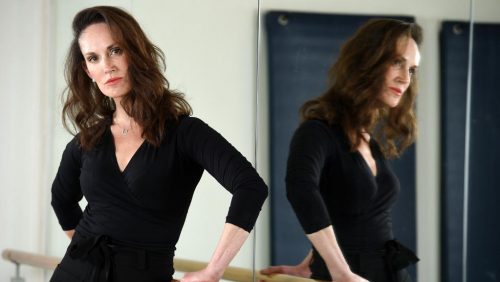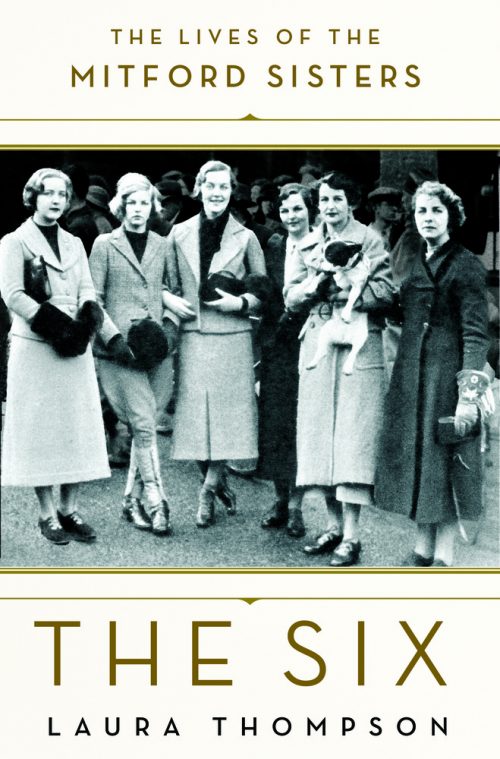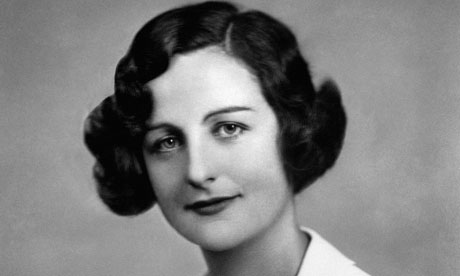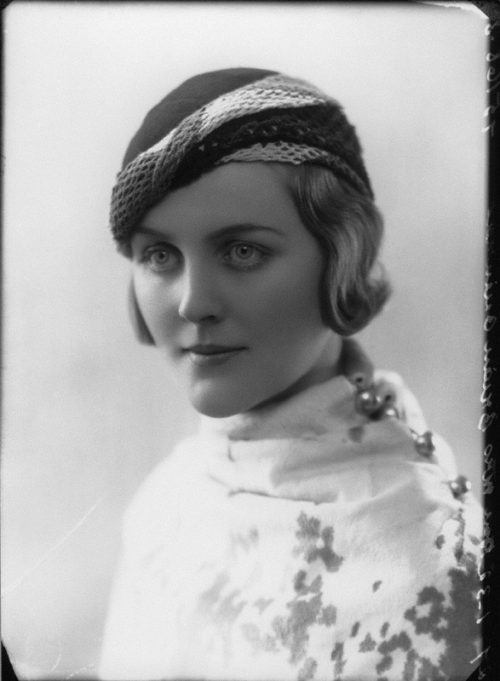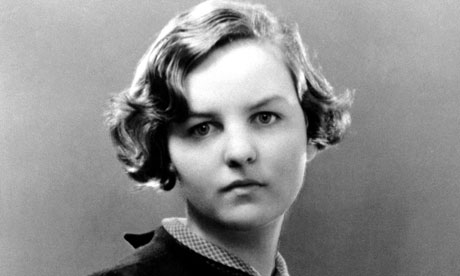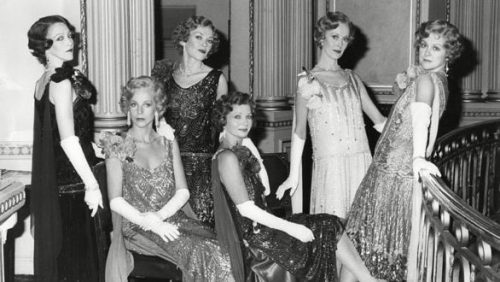To research The Six, Laura Thompson spent many dreamlike hours in the company of an aging Diana (who died in 2003), and experienced firsthand that heady charm that somehow captivated some of the brightest, the best, and the evilest men and women of her age. —Laura Michele Diener
The Six: The Lives of the Mitford Sisters
Laura Thompson
St. Martin’s Press, 2015
$29.99, 400 pages
.
I.
Thanks to Tolstoy, we know all about happy and unhappy families, and why unhappy families are by far the most interesting. Few families experienced quite such unique interesting incarnations of unhappiness as the Mad Mad Mitfords, the six sisters and one brother whose fates spanned the ideological spectrum of the twentieth century, and whose lives read like great English novels, except they actually wrote the novels, or they were friends with the novelists. Unity Valkyrie, the sister who adored Hitler, was conceived in the town of Swastika, South Africa. What writer could have invented a more perfect irony? As Laura Thompson, author of The Six: The Lives of the Mitford Sisters, declares, “Never again will there be six such girls, raised in such a way, at such a time.” And what times they were, those bright young years between the wars, before the world caught wholly afire. Nancy Mitford, the oldest of the sisters, although by no means the only authoress, wrote about the fictional Radlett family in her bestselling novel The Pursuit of Love, that, “they lived in a world of superlatives.” And rarely was it more clear that she found inspiration in her blood kin.
Their charm was collective as well as singular. Men from John Betjeman to Winston Churchill fell in love with one or the other of them or more likely, the whole lot of them, brother Tom included. After reading Brideshead Revisited, Nancy wrote to Evelyn Waugh: “So true to life being in love with a whole family, it has happened in mine.” Waugh himself was a lifelong devotee of the Mitfordian charm. He fell in love with Diana for a time but admired Nancy far more. Brideshead Revisited and The Pursuit of Love were both published in 1945, the year the war ended, and when great families like the fictional Flytes and the real Mitfords wondered where they fit into the new order. Both novels contain a melancholic nostalgia, but Nancy approaches her’s with out-and-out humor and what Thompson terms “a will to joy” that delighted a war-weary English audience.
Thompson identifies herself as a longtime admirer of Nancy Mitford. She has written a biography of her alone, Life in a Cold Climate (2003). “When I first read her, aged about thirteen, I could scarcely believe (so weighted down was I with Eliot and Hardy) that one was actually allowed this kind of pleasure, that literature could be souffle-light as well as monolithic, and still hold monolithic truths.” It is this tone of truth, delivered with a light and gracious hand that Thompson strives to imitate in The Six. She sparkles, delights, and barbs in the voice of Nancy. In Nancy’s classic style, Thompson peppers her book with epigrammatic gems:
“Feminism notwithstanding—female cleverness is still most acceptable when it spouts orthodoxies, or in some way conforms to a type.”
And then there’s that sharp Mitford prickle: “Few are the women who do not relish Nancy (her sisters were among the exceptions, but that’s another story).”
And a choice amount of dry observations:
“She [Nancy] was not especially good at men. In truth all her sisters (but especially Diana and Deborah) were better at handling men than Nancy. When the men in question include Adolf Hitler, one might justifiably say that this was not a gift worth having.”
And just as Nancy could unexpectedly lapse towards the lyrical, Thompson trills out a lovely turn of phrase. She describes the fortune of Diana’s first husband, Brian Guinness (of the brewery), as “the kind of wealth that shrugs off slumps and depressions, like coats falling from one’s shoulders.” Later she refers to “the strange echoing poetry of the Times social pages.”
In addition to Life in a Cold Climate, Thompson has previously written a biography of Agatha Christie—Agatha Christie: An English Mystery (2007)—and a biography of the infamous Lord Lucan, who in 1974 may or may not have attempted to murder his wife before he may or may not have committed suicide—A Different Class of Murder: The Story of Lord Lucan (2014). Her first book, the history of greyhound racing in England, won the Somerset Maugham Award. She is clearly fascinated with the eccentric, the wealthy, and the lovely (and, why wouldn’t one be? one of her genteel subjects might easily declaim). And while being healthily critical of class, she waxes nostalgic for the confident cleverness that sustained the Mitfords as they sailed through the grimmest years of the last century, writing, fighting, and speaking exactly as they pleased without apology.
Thompson attempts to describe the particularly Mitfordian way of stringing words together as “part-childish, part-posh, part-1920’s exaggeration . . . yet what makes it durable is the edge of perceptiveness, the nail on the head quality.” Not to mention an insistent British cheerfulness coupled with a blithe self-confidence. As Nancy wrote reassuringly to Jessica, worried about her daughter on holiday in Mexico, “People like us are never killed in earthquakes.”
Although Nancy’s writing became the most celebrated, all the siblings practiced wordsmithery. As children, they remoulded the English language into something quite thoroughly Mitfordian. Like the Brontës, the sibling pairs invented their own languages—“Boudledidge” and ”“Honnish”—and created an increasingly ludicrous string of nicknames: “Muv and Farve” (Mother and Father), “Boud” (Unity and Jessica), “Honk (Diana), and Stubby (Deborah).
II.
Without doubt the Mitford girls were born into immense privilege. Their family was of fine Saxon stock, dating back to pre-Conquest days. Although Nancy famously described their childhood home as unheated and uncomfortable, the girls occupied a cozy space right in the center of England’s interconnected maze of peerage. They possessed all the connections they would ever need to marry men like their father, David, Lord Redesdale, the first cousin of Clementine Churchill’s cousin (and if rumor was to be believed, potentially her half-brother.) Like other men of his class, he exercised his noblesse oblige in the classic manner, chairing charity committees and decrying the Labour Party in Parliament. In his spare time, he mismanaged his dwindling fortune and prospected for gold whenever he needed spare cash. His daughters later insisted they never had any money, and Nancy “came out” as a debutante wearing a homemade dress at a ball in her living room, with her aging uncles as dancing partners. But of course, Thompson remarks, “as poverty went, it was relative.”
Over the next ten years, three more sisters debuted into society, and the world darkened significantly. When the rumbling currents of Fascism and Communism exploded, the sisters gravitated to all ends of the political spectrum. Thompson pinpoints 1932, the year of Unity’s debut, as the moment when the charmed lives of the Mitfords all went to pieces, the year when Diana, sedately married to the charming if somewhat mousey Lord Brian Guinness, met the odious Lord Oswald, and for better or for worse (the reader can decide, but it’s pretty obvious where Thompson’s sympathies lie) hitched her glorious fortunes to his Fascist wagon. In 1932, Mosley was apparently walking sex, Flynn and Fairbanks combined, and had mesmerized a group of disenfranchised working-class men into believing that Fascism was the cure for a Depression-era Britain. An admirer of Mussolini and Hitler, he had begun the New Party, which then became the British Union of Fascists. His appeal to the unemployed working class was somewhat inexplicable: he dripped money, having married one of the daughters of the immensely wealthy Lord Curzon, all the while blithely sleeping with the other two, their step-mother, along with a dizzy array of chorus girls and peeresses. Despite, or perhaps because of his supreme self-confidence, Diana left her incredibly nice husband and his immense fortune, and set herself up in a little Eaton Square house near Oswald, faster than you could whistle “Lili Marlene.” “From that moment the Mitford family began to fall apart,” Thompson writes, “Unity and Jessica’s actions would be influenced by Diana’s nonpareil act of rebellion.” By the following year, the Black Shirts were promising change and threatening violence, and Diana’s adoration of Mosley led her to Berlin. After the unexpected death of his first wife, Diana and Oswald married in Berlin in 1936, with a begrudging Adolf Hitler by their side (apparently he too nursed a crush on the ethereal Diana.)
To research The Six, Laura Thompson spent many dreamlike hours in the company of an aging Diana (who died in 2003), and experienced firsthand that heady charm that somehow captivated some of the brightest, the best, and the evilest men and women of her age. She struggles to reconcile that utterly gracious soul of her acquaintance with the same Lady Mosley who elegantly heiled Hitler in old photographs. There must have been something to this woman who counted Lytton Strachey and Dora Carrington among her closest friends, and it must have been more than beauty (although golly gosh, she was beautiful, with a glamor that only existed between the wars, the kind only captured by black-and-white celluloid. On aesthetic grounds alone, it’s not hard to see why Nancy’s great friend Evelyn Waugh defected to Diana’s side for a few pre-Mosley years, dedicating Vile Bodies to her and adding in her husband Brian Guinness for form’s sake. “She seems to me the one encouraging figure in this generation,” Waugh wrote besottedly in 1929. Like the rest of his Bright Young generation, he was in line for a great deal of disillusionment.
Diana is a little too clearly Thompson’s favorite Mitford sister, and the number of comparisons she makes between Diana and fine sculpture verges on the excessive, (well-defined cheekbones don’t exactly outweigh a vacuum of human compassion), but Thompson does sincerely investigate her moral complexity. In fact, it is a credit to her biographical endeavor that she doesn’t dismiss Diana out of hand, but rather tries to sift through her paradoxes and view them in the context of her age. For generations, the English upper classes had admired all things Teutonic. Their paternal grandfather had been on intimate terms with Wagner, just as their father had been fast friends with his son Siegfried, hence Unity’s middle name of Valkyrie. Others wanted to simply avoid war at all costs. Even Nancy, the staunch patriot of the family, wrote after the war that everyone had gone to the German embassy in London. “They deny it now, of course.” Yet Thompson returns to the same question: “How, one wonders, did the Mitford love of laughter not cause her to fall about at the sight of Mosley in his black and his boots? Similarly—how could she have watched Hitler, screaming his nonsense at full volume, without the family sense of the ridiculous kicking in?”
In discussions of the sisters, Diana and her younger sister Unity get lumped together as the two who were pals with Hitler, but whereas Diana flirted with evil, Unity muddled merrily into its center. Thompson tackles the unexplainable Unity Valkryie, the artless, clumsy, Mitford giantess, who trounced guilelessly into Hitler’s affections, such as they were. At the very least her milkmaid good looks and childish prattling entertained him, so that before 1939, they met about 140 times, at tea parties, opera boxes, embassy balls, and other extraordinarily civilized settings. For all their Germanophilia, her family was baffled by increasingly unstable behavior and responded in their characteristically unhelpful ways. Her vile brother-in-law Lord Mosley referred to her as “stage-struck.” Nancy sent her mocking poems: “Call me early Goering dear/For I’m to be the Queen of the May.” Her alarmed mother tried to distract her with a cruise. Nothing changed, and Unity attended the Olympic games in Berlin alongside the Goebbelses, with whom she had become fast friends.
Thompson refers to her as an innocent, unstable, and generally mad young woman who fell in with the wrong (really the most absolutely wrong possible) crowd. “Perhaps they found the evil in her, as well as the madness.” Had she been born today would no doubt have been diagnosed on one or the other end of a spectrum and heavily medicated. When England declared war with Germany, she shot herself with a Walthur pistol. To her family’s guilty regret, the bullet left her alive but also incontinent and even more childlike (she was said to have the mental age of ten). With “something resembling human emotion,” Hitler returned her to the care of her mother in England, where she chattered away to kindly bewildered strangers about how Adolf would be the perfect name for the eldest of the ten children she knew she would have one day, and bestowed all the lively affection she used to reserve for Hitler on farm animals. “Oh, Boud, I have a Goat!” she wrote ecstatically to her Communist sister Jessica living in America. “In a strange way she had been the happiest of the sisters,” Thompson surmised. “Yet she had not a clue as to how to live.” She died in 1948 at the age of thirty-four from meningitis caused from the bullet wound.
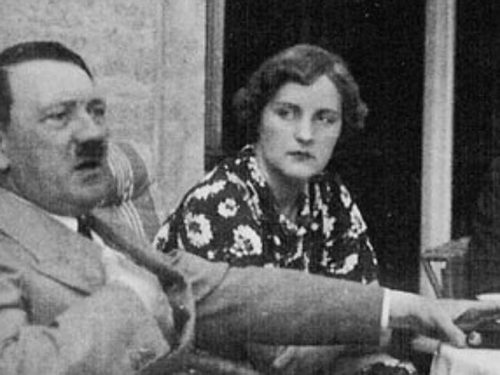 Unity Mitford and Adolf Hitler, 1936
Unity Mitford and Adolf Hitler, 1936
Unity and Diana defy easy explanation. It’s too easy to dismiss them as monstrous, without plumbing why they chose to spend their days among monsters. “The times in which this pair lived were terrifying: most people crossed their fingers, shut their eyes and prayed for it all to be over. For reasons that can never quite be explained, these aristocratic young women embraced it instead.” Perhaps with the cushions of youth, family, beauty, and money, they thought they had nothing to lose. Unity may never have understood what was at stake, and Diana (no one could call her cowardly) was always willing to risk it. “I can’t regret it,” she freely admitted in 1989. She was referring to her friendship with Hitler but could have meant the rest of it too—the love affair with Mosley, the break with propriety, and even the vitriol that awaited her in her home country.
After Britain declared war on German, the family fortunes shifted to a new set of extremes. Back in England, Diana and Oswald Moseley spent the war in prison as collaborators. Serves her right. She recalled it as an incredibly happy interlude, as for the first and only time in their marriage her husband was entirely faithful. And for a moment, you feel sympathy for this extraordinary woman and the cost of her choices. Family feeling was running high against her, as the other Mitfords did their bit for the war effort and then some. Tom, the inglorious but beloved Mitford brother, fought first on the North African front and then in Burma, where he died from a bullet wound in 1945. Pamela’s first husband, Esmond Romilly, serving as a pilot in the Canadian Air Force, was shot down somewhere over the North Sea in 1941. Nancy, experiencing the terror of the Blitz firsthand in London, went so far as to suggest to her friends in the Foreign Office that Diana was “an extremely dangerous person.” She had been throwing herself into war work since 1939, when she traveled to France to help Spanish refugees, and then back in England, where she operated a first aid post, drove an ambulance, and opened her home to Polish Jewish refugees, to the outrage of her mother (Hitler was her favorite son-in-law, Nancy always quipped). She also informed on her sister Pamela, whom she suspected of Fascist tendencies. Intriguingly, neither Jessica nor Nancy ever blamed Unity for her bizarre adulation of the Führer and the three shared gossipy loving letters throughout the war years.
III.
With their vastly different politics and their lifelong rivalry, Nancy and Diana act as the twin poles of The Six. Yet, as Mitford sisters go, it’s hard to resist the obviously spunky Jessica, who ran off during her debutante season to fight with the Spanish Guerrillas, and then married a Jewish lawyer in San Francisco, while her sisters were enjoying tea in Munich with Hitler. She later became deeply involved in the Civil Rights Congress, campaigned to legalize abortion, and basically fell on the right side of every modern feminist cauJese. She makes Lady Sybil Grantham look like a Tory living comfortably in Sloane Square. Yet Thompson cuts Jessica no breaks, portraying her as an extremist, just “more acceptable to history than that of her sisters. Such is the luck of the left.” She spends almost no time on Jessica’s acclaimed investigative journalism, including The American Way of Death, an expose of the money-grubbing funeral industry.
Poor old Pamela gets the least amount of space, but she appears less mysterious and controversial than her colorful sisters, spending the bulk of her adult life raising chickens and dairy cows, although apparently she innovated legendary technologies in the field of animal husbandry. Of Pamela, Thompson writes, “She had the unignorable presence of one of her grandfather’s shire horses.” Her rebellion may have been quieter. After her divorce from scientist Derek Jackson (himself a Fascist, but with the good grace to keep his beliefs to himself), she lived discreetly with a Giuditta Tommasi, and according to Jessica, “became a you-know-what-bian.” Like all her siblings except for Nancy and Jessica, she lunched with Hitler before the war, but was chiefly impressed by the chicken served.
The youngest sister, Deborah, came of age while her sisters were already making headlines on either side of the Atlantic. She rebelled against her mad mad family by embracing utter normalcy, at least for her rarified context. Two weeks into her successful debut season, she met her husband, a good Cambridge man, the second son of the Duke of Devonshire. When fate kindly swept him aside and made her Duchess, she resolutely managed her estates, holding up under the impositions of death duties and Labour politics. Despite her sex appeal, “the divine Debo,” as the press nicknamed her, stuck by her first sweetheart till death did them part. Very unMitfdorian, according to the sisters’ general self-assessment. “Debo’s absolutely pure,” Nancy reminded Diana, who had proclaimed, “We’re all adulterers and adulteresses.” While she spent literally three days at school, which she later recalled with self-deprecating horror (“no dog, no pony, no Nanny!”), she clearly inherited her fair share of family wit, publishing her own well-received chatty memoir, Wait for Me! (2010). Her death in 2014 was received with the kind of national outpouring of nostalgia reserved for the Queen Mum.
IV.
What with Unity’s antics, Diana and Lord Mosley’s unrepentant Fascism, and Lady Redesdale’s cheerful Teutonism, the Mitford’s were no one’s favorite family by the end of the war, and a prime example of why the average Brit wanted to chuck the class system down the chute along with the rationed coal. Hence the importance Thompson ascribes to the The Pursuit of Love in the creation of the Mitford myth: “Just as Diana led the troops into the darkness of battle by her defection to the Fascist cause in 1932, so Nancy did the same with her shift into the sunlight of public adoration.” The Pursuit of Love was not Nancy’s first book—she had been a successful novelist since 1931—but it was and would remain her most beloved. The delightfully eccentric Radletts are obviously the Mitfords refracted with affectionate nostalgia through Nancy’s effervescent voice. Their story is narrated by kind sensible cousin Fanny, who experienced life at her cousins’ estates at Aconleigh (based on Asthall Manor) during holidays, and later witnessed their multiple marriages and madcap escapades.
Nancy crisply layers the poignant and the hilarious together with a social observation worthy of Austen. On meeting her aunt’s new betrothed Fanny states: “My immediate impression was that he did not seem at all like a husband. He looked kind and gentle.” Her characters deliver social cuttings, devastating in the innocence of their delivery: “Oh the horror of important people—you are lucky not to know any.” All the elopements and scandals of the Mitfords are played for laughs, as when Linda Radlett leaves her banker husband for a Communist (a playful nod to both Jessica’s elopement and Diana’s affair, although neither appreciated the gesture). Linda innocently laments her new social life:
But I’m always saying to Christian how much I wish his buddies would either brighten up their parties a bit or else stop giving them, because I don’t see the point of sad parties, do you? And Left-wing people are always sad because they mind so dreadfully about their causes, and the causes are always going so badly.
Despite the ingenuousness of its characters, The Pursuit of Love contains a fair amount of darkness as the war threatens and then explodes around the Radlett children. But like Nancy herself, they cheerfully plunge forward into the new world that awaits them.
After the war, flush with the commercial success of her novels, Nancy moved to Paris, from whence she wrote fantastically funny letters to her family in that same tone of wide-eyed knowingness. She was always on, always entertaining. And even though Nancy was the intellectual of the bunch, the sisters were all clever and witty. As Diana wrote, referring to Jessica’s second marriage: “When all was said and done, Jessica was the only Mitford to ever harm a Jew.”
To be honest, it’s difficult to read Thompson’s book and not fall just a little in love with the intelligent, mysterious, and utterly original Mitford girls. Despite having only about two terms of school between them, they produced over twenty-five books, many of them award-winners and bestsellers, suggesting that childhoods full of animals, reading, and prodigious free time are highly underrated. Somewhere between riding to hounds and debuting, they must have learned something besides not putting the milk in first. They were funny enough and joyful enough that people still read their letters, and not just for the references to famous people who clustered around them. And their upper-class mannerisms, while out of fashion, are laced with just enough self-deprecation to read as charmingly ironic rather than insufferable. “After agricultural shows, Marks & Spencer is the place to go shopping, and then Paris,” Deborah declared definitively. “Nothing in between seems to be much good.”
“These girls are prize exhibits in a museum of Englishness,” Thompson insists. “And whatever one’s opinion of what they represent, it is impossible, in truth, to find them boring.” Rather.
—Laura Michele Diener
N5
Laura Michele Diener teaches medieval history and women’s studies at Marshall University in Huntington, West Virginia. She received her PhD in history from The Ohio State University and has studied at Vassar College, Newnham College, Cambridge, and most recently, Vermont College of Fine Arts. Her creative writing has appeared in The Catholic Worker, Lake Effect, Appalachian Heritage, and Cargo Literary Magazine, and she is a regular contributor to Yes! Magazine.
